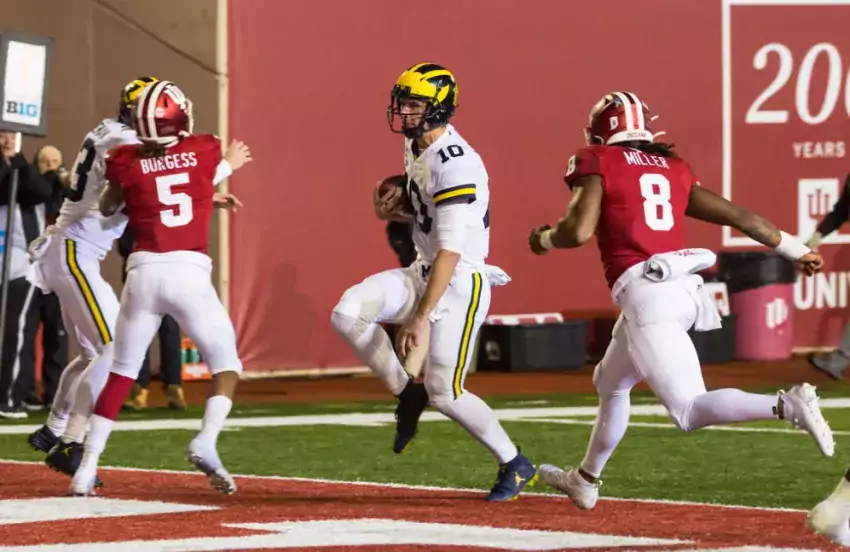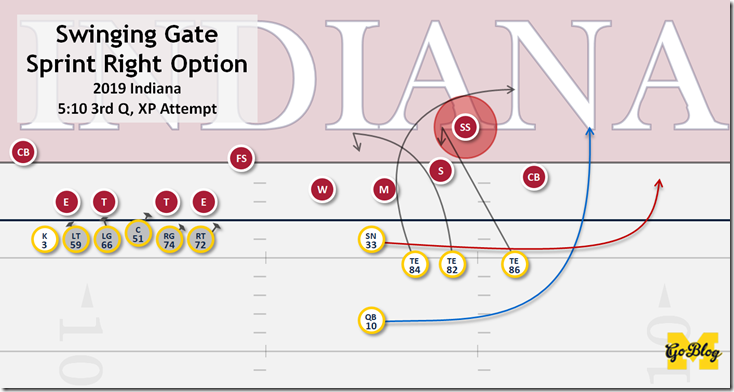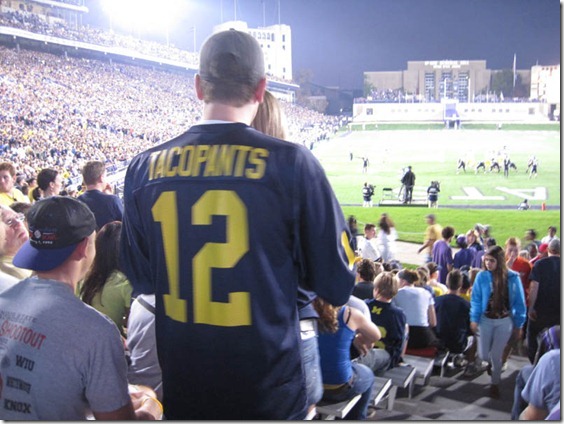two point conversions

(I wrote two this week. Second, longer one will post tomorrow)
Whether Michigan was correct to go for two to make it an 18-point game with over 20 minutes to play against an opponent with a top-15 offense is an argument best left for people who care if a team runs up the score.
HOW Michigan got its two-point conversion however is much more of mystery, thanks to ESPN's director failing to capture the play until a second after the snap, or show a review. I thought it highly unfair that Ryan Day gets the all-22 of this while Michigan fans never get to find out what happened. So I watched it a lot. And I'm pretty sure here's what happened:
Michigan used the old swinging gate tactic, caught at least one IU player (the WLB) napping, and ran a QB sprint option with the snapper as pitch-man and a travel pass option (plus two pick routes).
[After THE JUMP: How it worked, and how is it legal?]
So there's this.
Attached is a picture I took at the game. I'm sure you've seen people wearing Tacopants jerseys before, but thought it was apropos per Denard's 3 INTs.
-Nick
I'm not sure what's weirder: that there is an extant "Tacopants" jersey or the guy who emailed it to me thinks I've seen people—multiple people!—wearing them before.
I wonder why the Tacopants jersey guy picked 12. If I was going to create a Tacopants jersey he'd probably be 11 (his height in feet) or 8 (he's Jason Avant's imaginary friend) or 8i (obvious, probably not available). 12 seems random. I guess we are talking about a guy wearing a Tacopants jersey. Random is his middle name. Jason Random Tacopants.
Tacopants man! Explain your decision-making process!
Esoteric two-pointers.
Brian-
The internets have been all "lolzook" this week after the Illini's esteemed coach decided to go for 2 after scoring to take a 20-13 lead, then told a reporter in the postgame presser that they had a 5-point lead when asked to explain his decision. I'm not trying to push back on the lolzook, because obviously, but the situation brought to mind a piece of anti-CW Game Theory I've always held, although without a single shred of evidence to back me up. Maybe you can draw upon your vast resources to look into this so that next time I bring this up while watching a game with somebody, they won't look at me like I'm Ron Zook at that postgame presser.Now, to be clear, in the Ill-Ind game, I'd have kicked the extra point there. With that much time left, you maximize expected value.
BUT, if it were the 2nd half with the same situation (scoring 6 to go up 7), I believe that the correct Game Theory move is to go for 2. With possessions limited, the opportunity to make it a 2 score game far outweighs the advantage you gain by forcing a 2-point conversion, rather than an extra point, to tie.
Additionally, if you miss the conversion, and if the opposing team comes back to score, the opposing coach will virtually always elect to kick the extra point to send the game to overtime rather than go for 2, and the win, in regulation. In essence, with a standard-issue coach on the other sideline, the worst-case scenario in the "go-for-2" situation (miss conversion, opposing team scores, and kicks the extra point for a tie) is exactly the same as the worst-case scenario in the "take-the-point" situation (make the kick, opposing team scores and makes the 2-pointer to tie). But, the upside to going for 2 in that situation is significantly greater.
I'm interested to know what you think. I have a similarly insane Game Theory belief about going for 2 when you score to go from down 14 to down 8, but I'll save that for another day.
Regards,
Brian in Charlottesville
I don't think I agree. In the event of going for two:
Win: P(you2)
Tie: 1 - P(you2)
Going for one:
Win: 1 - P(them2)
Tie: P(them2)
With 2PT%s generally under 50% it doesn't seem like the right move. You want the burden of making the two pointer to fall on the opponent.
Also, as the team with the upper hand I also think you want the information about whether the two-pointer is successful to remain unknown. If you get it you've changed the opponent's calculus about how to win by collapsing the waveform. Armed with more perfect knowledge of their situation they will press forward knowing they are down two scores. The temptation to think "we're just one score down" when they are actually 1.6 scores down is strong. It causes a lot of lackadaisical behavior you do not see in teams down two scores late, which you like. So don't accidentally make the opponent play better.
If you pick up a penalty or are Wisconsin or have a gotcha two-pointer or are in a game that's going to end 58-51 the probabilities could swing in favor of going for it yourself; in an average situation leave it to the opponent. As always, context matters.
As for your "insane" theory you should go for it when you score to draw within eight, that is never going to happen in a game but has already been discussed by stat nerd types. This piece even uses the 2005 Notre Dame game as an example:
On September 10th, 2005, the University of Michigan football team was trailing by 14 points when they scored a touchdown with 3:47 left in their game against Notre Dame. Their coach decided to kick an extra point to get within seven points. Even though this strategy is followed in the NCAA and the NFL almost without exception, it is, in general, incorrect. In this paper I will show that the correct strategy in this situation is to immediately attempt the two-point conversion.
This is because you can make your choice about the second two-point conversion with the knowledge about whether the first one succeeded. So your chances, assuming that the 43% number given in the article is correct:
WIN: 43%
TIE: 57% * 43% = 24.5%
LOSE: 57% * 57% = 32.5%
By adopting that strategy you shift your chance of winning should you come back from the two TD deficit from 50-50 to about 55-45. They use a lot more detailed numbers to reach that conclusion but that's it in a nutshell.
A much better strategy is not be down 14 points.
On the armpit jerseys never dying.
Any thoughts or ideas as to why the defensive linemen switched to the road jerseys of the RR regime in the second half with the yellow piping? Also, Denard was wearing that one of those jerseys on the last drive. I like the look of this year's road jerseys without the yellow piping but wondering if if it is a fit or comfort issue although this year's home jerseys looked like they have the same fit with the wide, open arm-pit area.
Let's let another emailer answer this for me:
You've probably observed the same, but there are issues with the new Adidas techfits. I've seen them getting ripped to shreds at various points this season, and so you have guys like rvb, martin, roh, switch to last year's model in previous games. They were presumably asked to wear the new ones tonight given the more drastic change in appearance with elimination of the thick yellow piping. However, we've already seen rvb change back anyway despite the old piping.
I wouldn't normally care about this except for fact that underlying issue appears to be their tendency to be grabbed in a game-impacting way. Even fitz changed to the old jersey last game against Minn after being dragged down by the new techfit variety. We've seen the same thing happen to denard, although he hasn't switched. This is more annoying than anything else, especially to see potential big(ger) gains get stopped shorter than they should because some defender who was beat desperately was able to get a few fingers on some cloth.
We have seen a lot of guys dragged down by the jersey this year, haven't we? Could the Nike zealots have a point all of a sudden?
On OSU timelines.
Hello,
I’m writing because I am a little confused about the status of the Ohio State Investigation. I understand the NCAA came out with some findings earlier this year, but is that it? Are there still ongoing investigations? When will the findings/punishment be released?
-Kevin
OSU has proposed (laughable) self-sanctions at this point and had their meeting with the NCAA; they are now waiting for the final word. The comparable moment in the stretching Jihad is the middle of last season for Michigan, when they'd proposed and implemented the practice time penalties. Three months later the NCAA slapped on a token extra year of probation and issued their final report. OSU is in that period now.
Their ongoing issues with Posey, et al., complicate things. The NCAA is supposed to get back in 90 days—which would have been in the next few weeks—but has notified OSU that even more cripplingly obvious evidence the Buckeyes lack institutional control will have to be considered and then ignored.
So we just don't know, dude. Hopefully the new information pushes the decision date past the end of the season, just in case the NCAA decides to toss a bowl ban out. I'm actually surprised Gene Smith didn't announce one after the Nebraska game, because there's nothing the OSU athletic department loves more than brazenly late, transparently insincere actions designed to piss off the nation.
On instant replay ritual.
Brian,
I'm noticing more and more people are saying that when referees say: "The ruling on the field is confirmed" versus saying: "The ruling on the field stands as called", that they mean two different things, as if there's a level of indisputability that you need to "confirm" a call. I think that it's just two equal ways of saying that there wasn't enough indisputable evidence to overturn.
Can you clarify?
Thanks,
Simon
Boston, MA
They do mean two different things now. The "ruling is confirmed" means the replay official agrees with the call and "the ruling stands" means he just doesn't know, dude. This doesn't prevent replay officials from being violently wrong all the time, as they were when they did not overturn the Hawthorne interception, and still declaring the ruling "confirmed." This is because replay officials are crazy old Estonian men who have never seen football before in their lives.


47